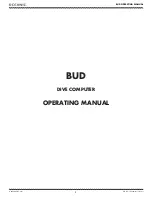
10
General Information
Multi-Conductor Cable
Conductors may be part of a multi-conductor cable provided that all conductors within the
cable are intrinsically safe. Each intrinsically safe conductor must have an insulation
thickness of 0.25 mm (0.010 in.) which is rated for the maximum temperature rating of the
approved device to which it is connected. The intrinsically safe wiring must be color coded
with light blue, if no other wiring is light blue or appropriately tagged.
Seals
A seal must be provided at the point the intrinsically safe wire passes between the
hazardous and non-hazardous locations to prevent the hazardous atmosphere from
entering the unprotected control room environment. The seal specification is that it must
not pass more than 198 cm
3
(0.007 ft
3)
of air per hour at a pressure equivalent to 6 in.
(1493 Pa) of water. While this is the same specification for the sealing requirements of an
explosion proof system, it may not be necessary to employ those seals.
Grounding
The 911 and 940 Flow Meters and associated Opto-Isolated Interfaces do not require
grounding or bonding. Under no circumstances should any attempt be made to ground or
bond the 911 or 940 Flow Meters or Opto-Isolated Interfaces.
2.1.5 Confined Space Entry
Important Note:
The following information is provided to guide users of 911 and 940 Flow
Meters on the dangers and risks associated with entry into confined spaces.
DANGER
Additional training in Pre-Entry Testing, Ventilation, Entry Procedures,
Evacuation/Rescue Procedures and Safety Work Practices is necessary to ensure
against the loss of life in confined spaces.
DANGER
Pour éviter les accidents mortels dans les espaces confinés, il faut organiser des
formations supplémentaires dans les matières suivantes: Contrôle avant entrée,
Ventilation, Procédures d'entrée, Procédures d'évacuation et de secours et
Méthodes de travail sûres.
On April 15, 1993, OSHA's final ruling on CFR 1910.146, Permit Required Confined
Spaces, became law. This standard directly affects more than 250,000 industrial sites in
the United States and was created to protect the health and safety of workers in
confined spaces.
2.1.5.1 Definition of Confined Space
Confined Space is any location or enclosure that presents or has the immediate potential
to present one or more of the following conditions:
•
An atmosphere with less than 19.5% or greater than 23.5% oxygen and/or more than
10 ppm Hydrogen Sulfide (H
2
S)
•
An atmosphere that may be flammable or explosive due to gases, vapors, mist, dust,
or fibers
•
Toxic materials which, upon contact or inhalation, could result in injury, impairment of
health, or death
Confined spaces are not designed for human occupancy. They have restricted entry and
contain known or potential hazards.
Examples of confined spaces include manholes, stacks, pipes, vats, switch vaults, and
other similar locations.
Содержание 911
Страница 2: ......
Страница 14: ...12 General Information...
Страница 16: ...14 Getting Started...
Страница 42: ...40 Meter Installation...
Страница 44: ...42 Software and Communications...
Страница 58: ...56 Sensor Installation...
Страница 68: ...66 Maintenance...
Страница 72: ...70 Replacement Parts and Accessories...
Страница 76: ...74...
Страница 88: ...86 Channel Installation Options...
Страница 92: ...90 Batteries and Chargers...













































